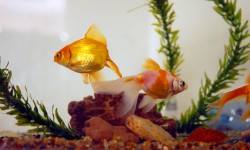Common Fish Diseases
 Much like dogs, cats, and other pets you may have in your house, your fish too can get sick with a number of diseases. Thankfully, there are a number of different treatments that can be used to take care of these sicknesses your pet can get infected with. Below is a list of common diseases and treatments that your fish may receive.
Much like dogs, cats, and other pets you may have in your house, your fish too can get sick with a number of diseases. Thankfully, there are a number of different treatments that can be used to take care of these sicknesses your pet can get infected with. Below is a list of common diseases and treatments that your fish may receive.
Probably the most common disease a fish can be infected with is the Anchor Worm. The Anchor Worms are small crustaceans that burrow into the fish’s skin and enter the muscles. Shortly after they burrow, they lay their eggs, and die, thus starting the process over again, and causing damage to the fish. There are several ways to get rid of the crustaceans, the most common including actually physically cleaning the infected areas with iodine, or giving the fish a warm, seawater bath for five minutes a day until the parasite falls off. Common symptoms include scratching against objects, inflammation, and greenish threads protruding from the skin.
Another common disease is body flukes, or flat worms. Symptoms for body flukes include a layer of mucus covering gills or body, reddened skin, drooping fins, and chewed on, or eaten away gills. Body flukes generally occur due to the poor environment they’re living in, but can occur when the fish is overcrowded, or if the fish is stressed. Flukes are also often present in aquariums usually, however can be controlled with ideal conditions. Body flukes can be treated with antibiotics, however it is generally suggested that Tetra Parasite Guard with praziquantel is used fist, and carefully administered. Another type of fluke that can occur is called a gill fluke, which features almost the same symptoms, but is located in the gills instead.
There are also other types of disease that can affect aquarium fish that are not worms, or crustaceans. These bacterial infections can cause diseases such as tail, fin, and mouth rot, as well as ragged tail fin. Generally, these infections occur to fish that are bullied, under stress, or who have been injured. Symptoms include the deterioration of infected areas, which is pretty noticeable. It can cause discoloration of scales or fraying of scales around the infected areas. To treat fish with this infection, the first thing that needs to be performed is a general water test, to test the health of the water. After this is done, there are a handful of multi-purpose antibiotic that should be used. Also, as an alternative, aquarium salt could be used as well.
One typically deadly disease called Hemorrhagic Septicemia can also infect aquarium fish, causing a number of different, internal issues. Unfortunately, there is no cure for this disease, but it is said that be treated to reduce mortality by using general antibiotics. Symptoms include hemorrhaging of internal organs, bulging eyes, open sores, red tint to the eyes, and abnormal behaviors. That being said, a lot of fish do not display any symptoms, unfortunately.
With all this being said, there are a number of things you can do from home to take care of your sick fish. However, it is suggested that a local veterinary doctor is seen before any treatment is conducted, as they will be able to fine tune the treatment for your pet.